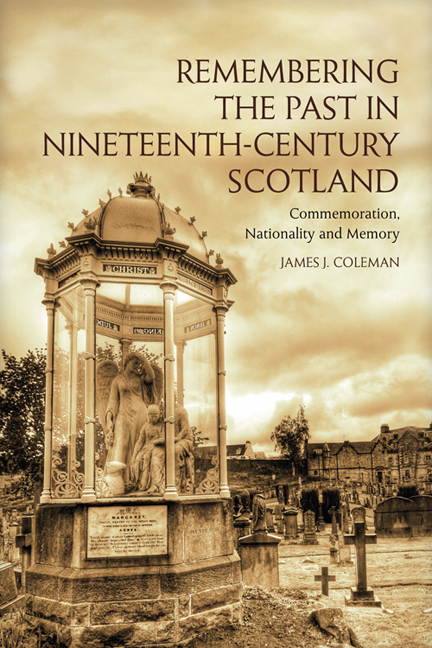Book contents
- Frontmatter
- Contents
- Acknowledgements
- Introduction: The Valley Cemetery
- 1 Nationality, Memory and Commemoration
- 2 Scottish Nationality in the Nineteenth Century
- 3 ‘Not Servile and Conquered, but Free and Independent’: Commemorating William Wallace and Robert the Bruce
- 4 ‘The Highest Position in the Civilised World’: Commemorating John Knox and the Second Reformation
- 5 ‘If They Were Rebels Then, We Are Rebels Now’: Commemorating the Covenanters and the Glorious Revolution
- 6 ‘By the Imprudence of His Ancestors’: Commemorating Jacobitism and Mary Queen of Scots
- 7 ‘Staunch Loyalty to the Flag that Stands for Union’
- Bibliography
- Index
2 - Scottish Nationality in the Nineteenth Century
Published online by Cambridge University Press: 05 August 2016
- Frontmatter
- Contents
- Acknowledgements
- Introduction: The Valley Cemetery
- 1 Nationality, Memory and Commemoration
- 2 Scottish Nationality in the Nineteenth Century
- 3 ‘Not Servile and Conquered, but Free and Independent’: Commemorating William Wallace and Robert the Bruce
- 4 ‘The Highest Position in the Civilised World’: Commemorating John Knox and the Second Reformation
- 5 ‘If They Were Rebels Then, We Are Rebels Now’: Commemorating the Covenanters and the Glorious Revolution
- 6 ‘By the Imprudence of His Ancestors’: Commemorating Jacobitism and Mary Queen of Scots
- 7 ‘Staunch Loyalty to the Flag that Stands for Union’
- Bibliography
- Index
Summary
REPRESENTING SCOTTISH NATIONALITY
Measured in terms of the symbols of nationality common across the rest of nineteenth-century Europe, there can be no doubt that the Scots held an assertive sense of themselves as a distinct nation. Rather than giving up their nationality in favour of British-national institutions, the Scots surrounded themselves with all the signs and symbols of a culturally and historically coherent nation. The Scots had a national museum and national gallery, national monuments, a national poet, national dress and national architecture, as well as a pantheon of national heroes, past and present. Indeed, Scotland in the nineteenth century suffered not so much from a lack of focal points for its nationality than from a surfeit. In the Victorian era there existed a collective pride bordering on collective egotism, an imperial arrogance bound up with landscape, industry, education and Presbyterianism.
This is not to say that all expressions of Scottish nationality were a great success. If there has been a tendency to view Scottish nationality in the nineteenth century as somewhat lacking, a correlative can be found in the National Monument on Calton Hill in Edinburgh, an early attempt to monumentalise Scottish national achievement. The monument was to be an enduring symbol of the vitality of Scotland's role in defeating Napoleon, while simultaneously crowning the capital as the Athens of the North, a status reflected in the monument's form as a classical temple, modelled on the Athenian Parthenon. The idea of raising such a colossal signifier of Scottish nationality was born from the wave of patriotic self-confidence that swept across Great Britain after victory over Napoleon, yet the post-war economic slump combined with poor organisation proved its undoing. There were some early successes: the foundation stone was laid in 1822 during the visit of George IV to Edinburgh, and the appointment of Charles Cockerell, one of Britain's most celebrated neoclassical architects, was a clear sign of the monument's lofty ambitions, yet the enterprise soon ran into trouble. Arguments over the significance of the monument, poor relations between Cockerell in London and William Playfair in Edinburgh, coupled with a marked lack of philanthropic support, stifled the construction process. The fragment that was built represents more of an early nineteenth-century job creation scheme than a symbol of Scoto-British greatness.
- Type
- Chapter
- Information
- Remembering the Past in Nineteenth-Century ScotlandCommemoration, Nationality, and Memory, pp. 20 - 38Publisher: Edinburgh University PressPrint publication year: 2014



